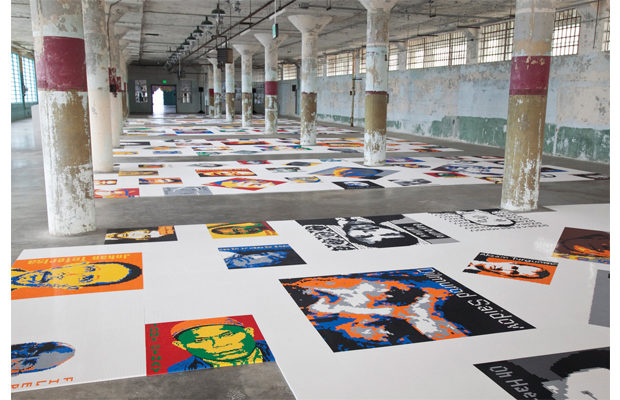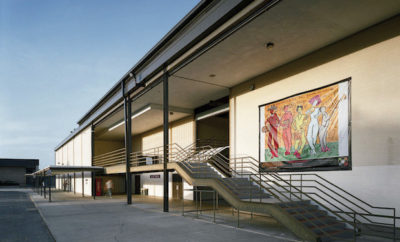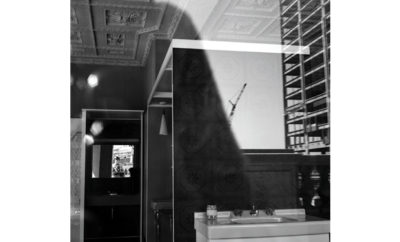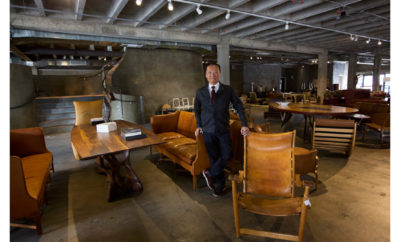
Architecture
Rock Star
The Ai Weiwei exhibition at Alcatraz points up the architecture of a too-little-appreciated building

The stabilized (partially restored) main floor of the New Industries Building on Alcatraz is the site of two installations by Chinese dissident artist Ai Weiwei. Trace, shown above, confronts the visitor with a field of colorful portraits of 176 people from around the world who have been imprisoned or exiled because of their beliefs or affiliations, with each likeness painstakingly constructed from LEGO bricks. The exhibition is organized by Foundation and on view until April 26, 2015. FOR-SITE foundation/Dan Stürmann photo.
Architecture is not the first thing that comes to mind when you think about Alcatraz. The notorious reputation of the craggy, twenty-two-acre island in San Francisco Bay dates back to 1933 when the “Rock” became the site of a federal penitentiary and a keystone of our collective imagination. Dozens of books and movies translated the lives of such prisoners as Al Capone and Robert “Birdman” Stroud into thrilling, if usually inaccurate, accounts of vile misdeeds and attempted escapes. (Stroud, for example, was not allowed to handle birds while imprisoned on the island.)
Today, the prisoners are long gone and Alcatraz is now a national park that hosts 1.3 million visitors annually and—occasionally—helps produce exhibitions, such as @Large: Ai Weiwei on Alcatraz, on view until April 26, 2015. Featuring seven site-specific installations created by the Chinese dissident artist, the widely publicized show also marks the regular opening of the newly stabilized (that is, partly restored) main floor of the New Industries Building. It is the rediscovery of this architectural treasure for which Ai’s exhibition may ultimately be best remembered.
Just four years after California was granted statehood in 1850, the federal government constructed the first West Coast lighthouse on Alcatraz and quickly moved to protect strategic positions around San Francisco Bay with impressive ramparts such as the Civil War-era fortifications at Fort Point on the Golden Gate and a garrison and stockade on Alcatraz. A decade later the stockade was used to hold Confederate prisoners and slowly grew into a federal prison whose security needs were mostly met by its remote location and the bay’s chilly waters. In 1933 the prison became a federal penitentiary to house the “worst of the worst.” So many facilities to accommodate prison administrators and guards went up that most of the structures weren’t named, just numbered. Among the exceptions was the large so-called New Industries Building, designed by the little-known architect Lewis C. Dunn, and built in 1939 and 1940 for $186,000.

The New Industries Building is the long, low, two-story building at the lower left in this view of Alcatraz. Ben Fash photo.
Constructed in the all-purpose, deco-inflected WPA style of the 1930s, the stucco exterior is nondescript, succumbing to both budgetary limitations and the difficulties of its hillside location. But the New Industries Building’s luminous interior is one of the largest single spaces constructed in California between the World Wars—and one of the most beautiful. Few public buildings of that era and size in the U.S. (it is 306 feet long) remain intact, save for former factories turned museums, such as Mass MOCA in western Massachusetts and the DIA Foundation’s branch in Beacon, New York. Like them, the New Industries Building’s shabby chic industrial aesthetic has enabled its conversion into a space amenable to the vast scale of so much contemporary art.
Divided lengthwise by two rows of columns, the building’s grandeur also evokes European cathedrals or millennia-old Egyptian temples supported by columns modeled on bundled reeds. And perhaps it is the sublime bay views that bring to mind the New Industries Building’s kinship with the subaqueous effect of the interiors of Frank Lloyd Wright’s S.C. Johnson Building in Racine, Wisconsin.
Both buildings embody at least a vestige of the Victorian belief in the beneficial—even redemptive—nature of work. Yet, while Wright’s dreamy office building optimistically evoked the desirability of white-collar office work, the value of labor in prison was regarded differently. At Alcatraz, work was mandatory and only privileged prisoners were entitled to earn a pittance from performing tasks that ranged from fabricating furniture and army uniforms to manning huge dry cleaning and laundry operations. The Alcatraz enterprises were also intended to help defray the high cost of incarcerating prisoners on an island where everything—even fresh water—had to be shipped in. This makes it doubly ironic that the New Industries Building was also home to the largest laundry facility in the Bay Area, servicing nearly the entire military population of Northern California. It was the expense of operating this American Devil’s Island that ultimately led Attorney General Robert Kennedy to oversee its closure and the transfer of its prisoners to a newly constructed, high security prison facility in Marion, Illinois, in 1963.
Why has this gem slipped through the cracks of time, especially in San Francisco, which pioneered the reuse of outmoded industrial buildings such as the Ghiradelli Chocolate Factory? Reasonable explanations abound: the building’s characterless exterior, its longtime inaccessibility, and the seventy-five years it spent marinating in salt water, ensuring its dilapidation. And then there’s the matter of Dunn, its non-celebrity architect who made little impression on the historical record.

Ai’s other installation in the New Industries Building, With Wind, is a contemporary version of the age-old dragon kite, its body made up of individual kites that carry quotations from activists who have been imprisoned or exiled, such as Nelson Mandela, Edward Snowden, and Ai himself. For Ai the dragon represents not imperial authority, but personal freedom. Scattered around the room are other kites decorated with stylized renderings of birds and flowers, which allude to a stark human reality: many are symbols of nations with records of restricting their citizens’ human rights and civil liberties. FOR-SITE foundation/Stürmann photo.
But I think this myopia goes deeper. In 1972, following the Native American occupation of Alcatraz and prior to its rebirth as a National Park, the National Park Service published a 650-page inventory of the island. It devoted scant attention to the New Industries Building, proclaiming that it possessed “no historical significance.” Surely our understanding of the intertwined architectural and human records has expanded beyond such one-dimensional judgments. The penitentiary’s stark dehumanization is embodied in both the crumbling setting of Ai’s chronicle of human-rights violations and by the restoration of a building whose soaring beauty was intended only to house something as mundane as a laundry. Such architectural artifacts are emblems of a highly charged and complex past that requires our remembering, but perhaps not always our reverence.












